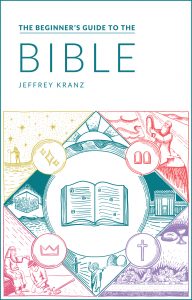I recently had the privilege of interviewing Dr. Douglas Moo. You may have heard his name before, especially if you’re a big student on the book of Romans. Dr. Moo is chair of the Committee on Bible Translation, the body of scholars responsible for keeping the NIV Bible translation up to date.
And it’s a big year for the NIV. This translation been around for 50 years now (which is a lot longer than I’ve been around). Plus, this year saw the launch of the NIV Zondervan Study Bible, a dream come true for those of us who love studying the Bible book by book.
Dr. Moo was kind enough to answer a few questions that I sent his way, and I’m excited to share them with you! (Thanks so much for your time, Dr. Moo!)
Jeffrey Kranz: Which biblical author did you and the CBT team find most challenging to translate, and why?
Dr. Douglas Moo: I suspect we faced our greatest challenge in the Psalms — we certainly spent a lot of time on this book! Poetry is difficult to translate in any language — so much meaning is bound up with stylistic features that are almost impossible to bring across: word play, similar sounding words, rhythm and rhyming schemes, etc. CBT worked hard at putting the Psalms in understandable English while retaining as much of the poetry as possible.
Jeffrey Kranz: What has been your most rewarding moment in your work of Bible translation?
Dr. Douglas Moo: For me, it is the appreciation we receive from both scholars and ordinary readers of the NIV. The scholar who commends us for getting the sense of a passage that they know very well is encouraging to us. But perhaps even more encouraging are the notes from believers who commend our work for its ability to communicate to them the meaning of God’s Word in English that they can appreciate and understand.
Jeffrey Kranz: Which book of the Bible do you feel is most “lost in translation” to English readers? Which book are we most predisposed to not get the context, tone, and purpose of?
Dr. Douglas Moo: I doubt that it has much to do with translation; but I think many readers continue to misread the Book of Revelation. They seek a blueprint for the “end times.” To be sure, Revelation has a lot to say about how history is going to end. But it is designed more importantly to communicate important theological truth about the nature and sovereignty of God, the plan he is infallibly bringing to pass and the comfort God’s ultimate victory brings to believers.
Jeffrey Kranz: In your paper, We Still Don’t Get It, you say that “meaning resides not at the level of individual words but at the level of collocations of words in clauses, sentences, and ultimately discourses.” Do you have an example or illustration that can help us communicate this principle to our friends, small groups, and congregations?
Dr. Douglas Moo: Let me illustrate the advantages of the NIV approach with a particular text.
Elizabethan English had one clear advantage over modern English: the ability easily to distinguish between second singular and second plural forms. Note the KJV translation of Luke 22:31-32:
And the Lord said, Simon, Simon, behold, Satan hath desired to have you, that he may sift you as wheat: But I have prayed for thee, that thy faith fail not: and when thou art converted, strengthen thy brethren.
The KJV clearly conveys the difference in Greek between second singular and second plural. In verse 31, “you” renders the plural Greek pronouns: Jesus tells Simon Peter that Satan is attacking all the apostles. In verse 32, then, the KJV signals the shift in Greek to second singular forms by using “thee,” “thy,” and “thou”: Jesus is praying specifically for Simon Peter. Modern English versions following an “essentially literal” or “word-for-word” approach cannot convey this difference: since “you” is the appropriate dictionary meaning for both singular and plural second-person pronouns, these verses simply plug “you” into each of the places where the second singular pronoun occurs. But listen to the NIV:
“Simon, Simon, Satan has asked to sift all of you as wheat. But I have prayed for you, Simon, that your faith may not fail. And when you have turned back, strengthen your brothers.”
Because the NIV philosophy is to get the meaning across, not getting hung up on the form, we can qualify “you” in verse 31 with “all” to make clear the pronoun here is plural and add “Simon” after “you” in verse 32 to show that the pronoun here is singular.
Jeffrey Kranz: My Alma mater taught me systematic theology, but the NIV Zondervan Study Bible prefers biblical theology. How would you explain the difference between systematic and biblical theology?
Dr. Douglas Moo: Scholars continue to debate the precise differences between biblical and systematic theology. I think I can speak for the editors and contributors to the NIV Zondervan Study Bible when I say that our focus on biblical theology is by no means intended to denigrate or dismiss systematic theology. Many of the basic questions we ask about life can only be answered at the level of systematic theology. But biblical theology is an indispensable stage on the way to systematic theology. Biblical theology stays a bit closer to the text of Scripture and generally organizes itself around the language and categories found in Scripture itself. It is also much more geared to the historical unfolding of God’s purposes in history. Of course, it is just these matters that make biblical theology a natural focus for a study Bible.
Sidenote for you readers: thinking of making an infographic explaining the differences/similarities between systematic and biblical theology. Is this something you’d be interested in seeing? Leave me a note in the comments! Now, back to the interview . . .
Jeffrey Kranz: What do you think the next 50 years of Bible translation will look like? What are the next hurdles we will need to jump?
Dr. Douglas Moo: I am convinced that neither the church at large nor Bible translation in general has grappled adequately with declining levels of literacy. Fewer and fewer people can read well — quite a problem for a movement that is based on careful reading of a Book! Bible translations that do a great job of capturing the original meaning in a level of English that most people cannot understand remind me of the famous cartoon that reminds us to plan ahead: the bridge firmly anchored on one shore that ends in the middle of a waterway. Translation is communication; and we must work harder at figuring out what kind of English our target audience can understand. We work as hard on English as we do on Hebrew and Greek on CBT. We are trying to produce in the NIV a translation that communicates broadly to a worldwide population of English speakers. But, realizing that our best efforts will not suffice for everyone, we also offer the NIrV, the New International “readers’” Version, that takes all of our CBT decisions and puts them at a 3rd-grade level of English: perfect for children and those many millions who are learning English as a second language.
Jeffrey Kranz: Which questions you wish people would ask you more often, and how would you answer them?
Dr. Douglas Moo: I really enjoy answering questions (such as the one I just answered from a former student) about why CBT decided to translate a verse a certain way. I am an exegete at heart, and I really like helping people see the exegetical decisions that lie behind our translation. Too many people simply criticize the NIV rendering, as if we simply didn’t think of something or ignored something obvious in the text. However, while the NIV is not perfect, it is probably the English translation that has had the most careful scrutiny of any other. CBT has worked through the whole Bible several times; we regularly enlist outside scholars to help us; and all kinds of NIV readers regularly send us suggestions. So it is very unusual for someone to raise an issue that we have not considered at some point. Our decision may not agree with everyone else; but we have looked at the data. I love helping people see how this has happened, and what the evidence was that led us to a certain translation.
I also wished that more people asked careful questions about process. The NIV is one of the few English Bibles that is produced by an independent and widely representative group of evangelical Biblical scholars. Our work is not influenced by a publisher or any other organization. CBT is wholly independent; only we can make changes in the text of the NIV. In a day when evangelical Christianity seems to be dividing up into more and more factions, the vision of a translation “owned” by the evangelical movement as a whole — with no particular denominational or theological bias — is worth recapturing.
Thanks again for your time, Dr. Moo! It’s a true privilege.
If you’d like to pick up the NIV Zondervan Study Bible, you can do so here.* If you’re already a fan of Dr. Moo’s work, you may want to check out his video course on the book of Romans.*
* Sometimes I’ll partner with organizations to help more people know about their resources—in return, they give me a kickback when people purchase. This is one of those times. ;-)



I found this article when I searched a bit on Douglas Moo, and it was so good I sent it to a friend! I loved getting to hear more from a scholar who worked on the NIV, my favorite translation ☺
Isn’t he great?!
(Thanks for sharing, by the way!)
Please create an infographic explaining the differences/similarities between systematic and biblical theology
Please create an infographic explaining the differences/similarities between systematic and biblical theology
Just came across this article. Thank you so much for posting it. My biggest question is, what is the major differences between the recent NIV and ESV? I grew up in the faith using NIV 84, and I switched to ESV a few years ago. I’ve heard that the more recent NIV translation is not as good as the 84 translation. Can you shed some light on this?
https://www.youtube.com/watch?v=EIXS5Ydbrsk – check this out and make your own mind up.
This was an interesting read ~ I’m curious to check out the Study Bible now. :)